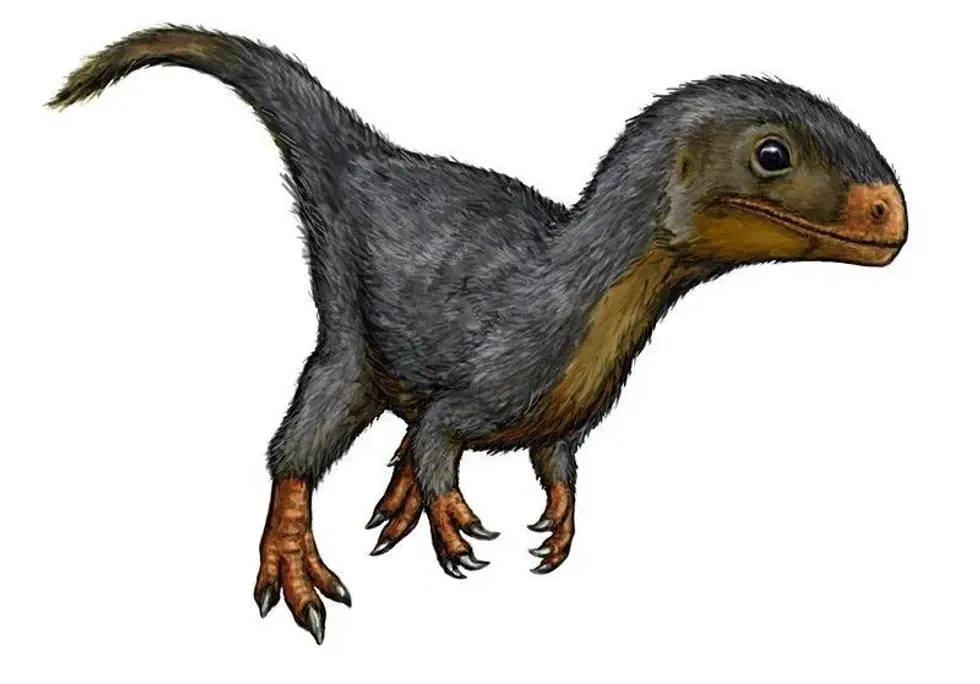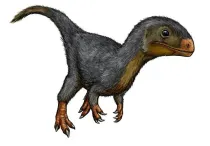Daemonosaurus (meaning Demon lizard) is a genus consisting of an extinct medium-sized theropod. This genus has only one species, D. chauliodus.
It existed between 208.5-201.3 million years ago in the Norian of the Late Triassic period. It was named in 2011 by Amy C. Henrici, David S. Berman, Sterling J. Nesbitt, and Hans-Dieter Sues.
The name of this genus is derived from 'daemon' that means demon and from 'sauros' that means reptile. The specific name of the species originated from the Greek term 'chauliodous' which means prominently toothed.
The name of the type species of this genus is kept after its teeth. It belongs to the clades Dinosauria and Dracohors.
The fossil remains of this dinosaur were discovered from Ghost Ranch quarry, Chinle Formation, New Mexico, USA and consists of vertebrae, ribs, and a skull. It was described by Amy Henrici, David Berman, Sterling Nesbitt, and Sues, and its length is estimated to be between 4.9-7 ft (1.5-2.2 m) and weighed between the range of 20-49 lb (9-22.2 kg).
The skull of this dinosaur was quite unique and was not similar to any dinosaur that co-existed with it. Its large upper teeth were fixed on its short snout and projected forward.
The same can be seen in its lower jaw. This theropod also possessed an exceptionally large eye socket.
Its exceptional features caused it to be placed between the later theropods from such as Tawa and the earliest known theropods like Eodromaeus. This dinosaur is believed to have been a carnivore and an extraordinary hunter of its times.
Enjoyed reading these fun Daemonosaurus facts? Keep reading to discover more facts about its features, history, relationships, and more!
If you loved reading our fun Daemonosaurus facts, you must check out our Lanzhousaurus and Podokesaurus interesting facts as well!
Daemonosaurus Interesting Facts
How do you pronounce 'Daemonosaurus '?
Daemonosaurus can be pronounced as 'day-mon-o-sore-us'.
What type of dinosaur was a Daemonosaurus?
It is an extinct genus that comprises only one species, D. chauliodus. This reptile was described and named by Amy Henrici, David Berman, Sterling Nesbitt, and Sues. It is a theropod dinosaur that is placed in between later theropods from such as Tawa, and the earliest known theropods like Eodromaeus. It belongs to the clades Dinosauria and Dracohors.
In which geological period did the Daemonosaurus roam the earth?
These dinosaurs are estimated to have existed during the Norian of the Late Triassic period. The specimen excavated from Ghost Ranch in New Mexico is estimated to be around 200 million years old.
It is believed to have occurred after Tawa as it was found in the same quarry where numerous skeletons of Coelophysis were discovered. Tawa is related to Coelophysis closely, but Tawa occurred earlier and ceased to exist before it.
This suggests that the Daemonosaurus belongs to a group of theropod dinosaurs that dwelled in North America and lived along with theropod groups that were evolved newly. These relationships can only be revised once more specimens are discovered.
When did the Daemonosaurus become extinct?
It has been estimated from the specimens that the Daemonosaurus dinosaur went extinct 201.3 million years ago.
Where did a Daemonosaurus live?
The fossils of this dinosaur were found in Ghost Ranch quarry, Chinle Formation, New Mexico, USA, suggesting that these dinosaurs dwelled in North America. It is believed to have been endemic to North America as no specimen has been discovered elsewhere to date.
What was a Daemonosaurus's habitat?
This dinosaur was bipedal and dwelled in a terrestrial habitat where it could easily find prey.
Who did a Daemonosaurus live with?
These dinosaurs are believed to have been lethal predators. It has been hypothesized that it hunted in packs, with each pack led by an alpha dinosaur.
It is believed to have co-existed with the Chindesaurus dinosaur, whose remains have been discovered from the same formation as that of the Daemonosaurus. The Chindesaurus has been described based upon a postcranial skeleton whereas the Daemonosaurus has been described from ribs, vertebrae, and skull.
It is being assumed that maybe the Chindesaurus and the Daemonosaurus are the same or closely related.
How long did a Daemonosaurus live?
The lifespan of these Late Triassic dinosaurs is not yet known. However, we do know that that the mighty theropod, the Tyrannosaurus rex, had a lifespan of two years!
How did they reproduce?
These dinosaurs are believed to have reproduced by laying eggs.
Daemonosaurus Fun Facts
What did a Daemonosaurus look like?

The appearance of this dinosaur is based on the fossil remains discovered that include some vertebrae, ribs, and skulls. It has a short-snouted skull which is quite unique and is not similar to any dinosaur that co-existed with it.
It is not alike the elongated skull of theropod such as the Coelophysis nor is it like the boxy skull of the Herrerasaurus. The skull of D. chauliodus was deep, narrow, and measured 5.5 in (13.9 cm) from the back to the snout's tip.
Its large upper teeth were fixed on its short snout and projected forward. They were curved and prominent, not sharp.
The same can be seen in its lower jaw. This theropod also possessed an exceptionally large eye socket.
How many bones did a Daemonosaurus have?
This dinosaur is based upon a few vertebrae, ribs, and skulls that were excavated. It is not yet known how many bones it had.
How did they communicate?
It is not known how they communicated. However, it is believed that theropods are communicated through visual displays.
How big was a Daemonosaurus?
It is estimated that this dinosaur ranged between 4.9-7 ft (1.5-2.2 m) in length. This length is based upon the measurements of other basal theropods that are related to it.
It is also not certain if the skull is of an adult or a juvenile. The absence of fusion between the bones of its braincase and the large eye socket suggests that the fossils discovered are of a young dinosaur.
The length of this dinosaur is still larger than the Jeholosaurus. The Jeholosaurus is a small-sized dinosaur that measures only 28 in (71.1 cm) in length.
How fast could a Daemonosaurus move?
The exact speed of this dinosaur is not known. However, we do know that all theropods were quite agile and could sprint very fast
How much did a Daemonosaurus weigh?
It has been estimated that this dinosaur must have ranged between 20-49 lb (9-22.2 kg) in weight.
What were the male and female names of the species?
There are no sex-specific names assigned to the males or females of this species.
What would you call a baby Daemonosaurus?
The baby of species of this genus can be referred to as a hatchling or juvenile.
What did they eat?
These dinosaurs were carnivores and fed upon other animals.
How aggressive were they?
These dinosaurs are assumed to have been quite aggressive as they fed upon other animals. They were also medium-sized which suggests that they were powerful as well.
Did you know...
The fossils of these dinosaurs can be seen at the Carnegie Museum of Natural History, in Pittsburgh, Pennsylvania.
Who discovered Daemonosaurus?
The Daemonosaurus was discovered in 2011 at Ghost Ranch. It was described and named by Amy C. Henrici, David S. Berman, Sterling J. Nesbitt, and Hans-Dieter Sues.
What do you mean by Daemonosaurus?
It was named in 2011 by Amy C. Henrici, David S. Berman, Sterling J. Nesbitt, and Hans-Dieter Sues. The name of this genus is derived from 'daimon' that means demon and from 'sauros' that means reptile.
The specific name of the species originated from the Greek term 'chauliodous' which means prominently toothed. The name of the type species of this genus was kept so as it was a buck-toothed dinosaur.
Here at Kidadl, we have carefully created lots of interesting family-friendly dinosaur facts for everyone to discover! Learn more about some other creatures from our Velocipes facts and Melanorosaurus Interesting facts for kids.
You can even occupy yourself at home by coloring in one of our free printable Daemonosaurus coloring pages.
Main image by Michael B. H.
Second image by Jaime A. Headden.










